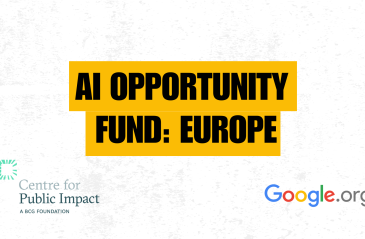
The power of storytelling in climate leadership

Check out CPI's survey on government innovation and the hype cycle
Share articleWhich technologies and approaches are the most popular for governments?
Share articleAre governments deploying digital rapidly or slowly? Take our survey to have your say!
Share articleWe put our vision for government into practice through learning partner projects that align with our values and help reimagine government so that it works for everyone.
Every government says that it is committed to deploying the best of digital technology to improve its performance and the public services their citizens rely on. That's no secret. But does the rhetoric match the reality?
The Centre for Public Impact is conducting a survey which aims to identify which technologies and approaches are proving the most popular amongst administrations worldwide - all mapped against Gartner's hype cycle.
Generally used for companies in the private sector to manage their deployment strategies and exploit new opportunities, the hype cycle can provide a helpful and entertaining way to map how a technology develops in government.
The IT research and advisory firm Gartner developed this graphical representation of the stages a new technology goes through before it reaches maturity. It illustrates how new technologies start in the technology trigger phase, climb the peak of inflated expectations, fall into the trough of disillusionment, and traverse the slope of enlightenment before arriving at the plateau of productivity:
Hyperbolic expectations of the early and courageous first users become more realistic and eventually the technology hits mainstream adoption. Some, of course, never make it to the end and fall into the graveyard of discarded ideas.
Last year we estimated where 10 government innovations were along the hype cycle. This year, we are running a survey on 10 key technologies and innovative working methods and their place along the cycle. It's an interactive way for people to tell us at what stage of adoption these technologies (which include e-government, artificial intelligence, new public management, design thinking and others) are in the public sector.
For instance, new public management is a methodology that was introduced during the time of Margaret Thatcher and has come a long way since the 1980s, when it struggled with concerns that public managers would move away from trying to meet citizens' needs, to being embedded productively in government practices. A more recent innovation like blockchain might still be very much in the actual “hype” stage. There isn't yet a full understanding of its applications, but as a radical security tool, blockchain has the potential to improve transparency and check corruption in governments worldwide.
The popular perception is that technological adoption is slower in government than in the private sector, but this may not be true. A 2015 survey conducted by Arizona State University found that governments were ahead of private sector firms when it came to adoption of new ICT and in particular social media applications.
As organisations, governments have certain structural advantages over private firms, in particular, their relationship with citizens is quite different from the one between firms and their clients (governments can exercise coercive authority over their citizens unlike firms where clients can leave if they are dissatisfied with the service). Government might therefore have more leeway to experiment with things where the end result is unknown. Given that all these methods have the possibility of making valuable contributions where citizens would reap the benefits, it might be worth persevering all the way through to the plateau of productivity.
Our survey aims to help give further clarity to such questions - and we look forward to reporting back on the findings later this year.











